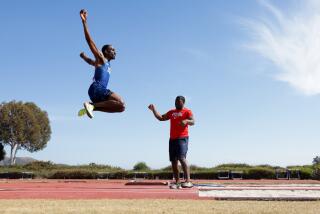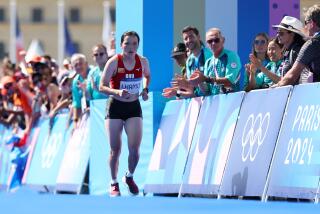No Limits, in Her View
SACRAMENTO — The first words Marla Runyan ever spoke foretold the theme of her life.
Her father, Gary, spelled them out. “I wanna do,” he said. “I w-a-n-n-a do. She used to say that all the time.”
That remains true of her at 35. The former Camarillo resident has been an elite heptathlete at San Diego State, a marathoner, 1,500-meter runner and, as of Monday, an Athens Olympian at 5,000 meters. Before that, she was a violinist -- she occupied the first chair of her school orchestra -- earned a bachelor’s degree in education of the deaf and a master’s degree in education of deaf-blind children.
All this despite losing much of her sight to Stargardt’s disease, a disorder of the retina that diminishes the eye’s central vision.
She couldn’t see the water stations when she was the top American finisher at the 2002 New York City Marathon, crossing the finish line in 2 hours 27 minutes and 10 seconds. She couldn’t see the bar when she high-jumped in the heptathlon, yet she ranked fourth in the U.S. in 1999 and 10th in the world.
No Paralympian had ever competed in the Olympics, yet she finished eighth in the 1,500 four years ago at Sydney.
Runyan sees what’s important in life and shuns labels or limitations. Her resolve undoubtedly was shaped by her mother, Valerie, who died of cancer a few years ago, and by her father, who rejected a doctor’s initial diagnosis that she had hysterical myopia and “things going on in her head” when she was 9 and could no longer clearly read the chalkboard at school.
Gary Runyan recalled being told he and his wife should visit other families whose children had Stargardt’s so they’d learn what they’d face.
“All these parents would do was to tell us what we could expect Marla not to do,” he said. “‘Don’t expect her to do this, don’t expect her to graduate ... to play sports.’”
Finally, he’d heard enough.
“We made an out-loud, conscious decision,” he said. “ ‘OK, here’s the deal. We’re going to let her do what she wants to do. We’re not going to set any artificial barriers. She’ll have to find her own barriers, because only she is going to know what she can do and can’t do.’ And that became our goal from that day forward.”
Runyan has yet to find a barrier she can’t overcome.
She hadn’t run the 1,500 in four years when she placed fourth at that distance at last month’s Prefontaine Classic in her adopted hometown of Eugene, Ore., and missed the Olympic “A” standard by 57 hundredths of a second. She said Tuesday she’s strongly inclined to pursue the Olympic standard of 4:05.80 in Friday’s 1,500 semifinals, incredulous anyone would wonder why she’d run and not simply assume her philosophy would be, “Why not?” Her personal record in the 1,500 is 4:05.27, set in 1999.
“If I’d just run the 1,500 the last four years I’d probably have a faster PR,” she said at a news conference in her honor organized by the Perkins School for the Blind, for which she serves as an ambassador.
“I think my potential in the 1,500 is under four minutes. I made the choice: I just wanted to do other events. I wanted to try the marathon. I just didn’t want to be limited to one event.... Here at the Olympic trials, I don’t feel exhausted. I feel ready for the season.”
She was still sore the morning after the 5,000, joking she might have held off the onrushing Shayne Culpepper “if I’d just leaned.” But she praised Culpepper, third-place finisher Shalane Flanagan of the University of North Carolina and the overall depth of the field. “I really feel proud of my competitors as well,” she said. “We push each other.”
And no, she said in response to a question, it wasn’t because of her poor vision that she didn’t react to the onrushing Culpepper in the final few strides.
“Did my sight make my legs buckle underneath me?” she said, enjoying the ensuing laughter.
“I think my lack of confidence played a factor. I started my kick too soon ... and didn’t realize where Shayne was. She got me. She timed it perfectly.”
Runyan’s grace and grit have made her an ideal representative for the Perkins School, its director of development and public relations, Jan Spitz, said after showing a video of Runyan’s last visit to the school in June.
“Our motto for our 175th anniversary is, ‘All we see is possibility,’ ” Spitz said, “and all we see is possibility for you as you head to Athens.”
The video showed Runyan accompanying several Perkins students as they jogged, walked or wheeled around the school’s indoor track, some clearly terrified and others exhilarated. She challenged them to take a month to travel the 180 or so laps it would take to cover the distance of a marathon and keep a log of their progress. “I had an e-mail from one girl who said it was too easy and I need to give her a new challenge,” Runyan said, smiling.
“These kids, they inspire me. They have overcome a lot in their lives.”
So has she -- and she’s prepared to face more, or suggested as much by saying she’s leaning toward returning to the marathon at the next Olympic trials. She will pass her 39th birthday before the Beijing Games.
“I do think of myself as young,” she said. “My breakthrough was in ’99. My running legs are only 22 though my age is 35.
“I still think some of my best races are to come.”
More to Read
Go beyond the scoreboard
Get the latest on L.A.'s teams in the daily Sports Report newsletter.
You may occasionally receive promotional content from the Los Angeles Times.







